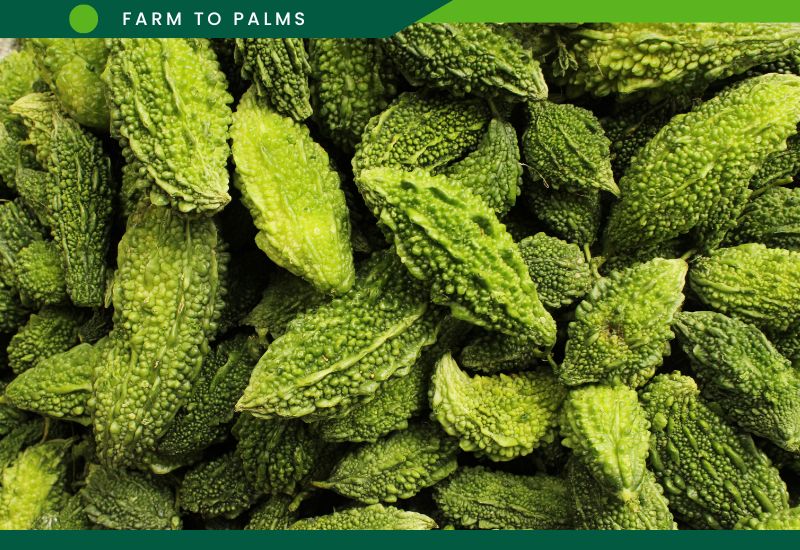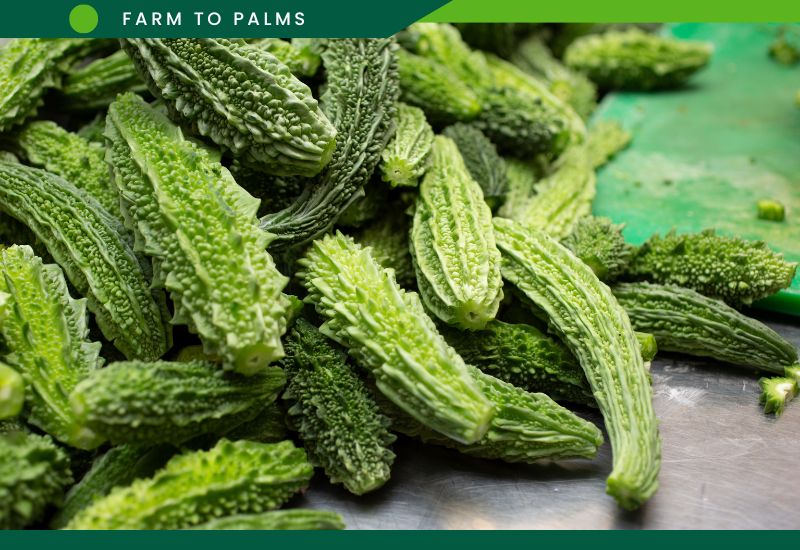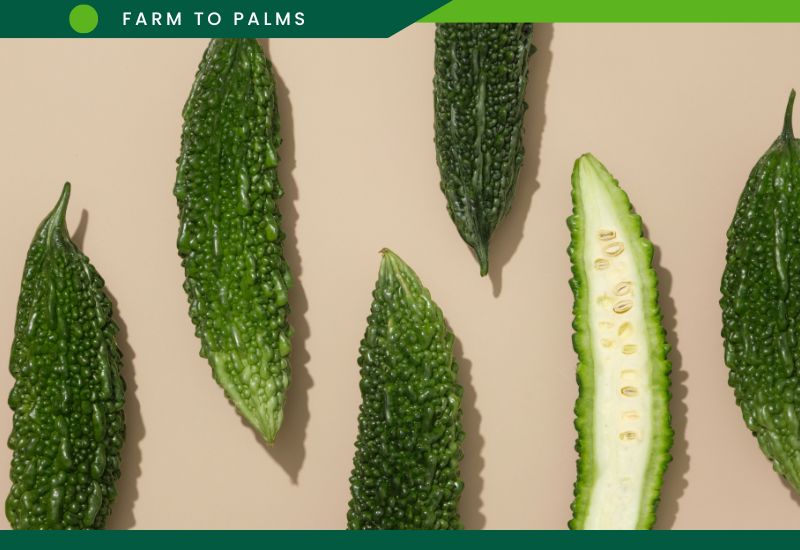Bitter melon, also known as bitter gourd or Momordica charantia, is a tropical vine belonging to the gourd family. It shares close botanical ties with zucchini, squash, pumpkin, and cucumber. Widely cultivated globally for its edible fruit, it is significant in various Asian culinary traditions.
Bitter melon, with its long, pale green fruit covered in wart-like bumps, or its Indian counterpart, characterized by a more slender shape with pointed ends and rough, jagged spikes on its rind, is a unique addition to any culinary tradition. Beyond its distinctive appearance and sharp taste, bitter melon has garnered attention for its potential health benefits.

Let’s explore six notable advantages associated with bitter melon and its extract.
Packs several important nutrients
Bitter melon is a valuable source of various essential nutrients. In a 100-gram serving of raw bitter melon, you can find:
– Calories: 21
– Carbohydrates: 4 grams
– Fiber: 2 grams
– Vitamin C: 99% of the Daily Value (DV)
– Vitamin A: 44% of the DV
– Folate: 17% of the DV
– Potassium: 8% of the DV
– Zinc: 5% of the DV
– Iron: 4% of the DV

Bitter melon stands out for its high vitamin C content, which is crucial for disease prevention, bone health, and wound healing. It is also rich in vitamin A, supporting skin health and vision. Additionally, it offers folate for growth and development, along with smaller amounts of potassium, zinc, and iron. These nutrients make bitter melon a valuable addition to any diet.
Moreover, bitter melon contains beneficial antioxidant compounds like catechin, gallic acid, epicatechin, and chlorogenic acid, which protect cells from damage. Despite being low in calories, bitter melon is a high-fibre food, providing roughly 8% of your daily fibre requirement in just a one-cup (94-gram) serving.
How to eat bitter melon

Bitter melon has a unique and robust flavor that some people enjoy. Here are some tips to help you prepare and enjoy bitter melon better:
Preparing the Melon
- Wash the bitter melon and cut it in half lengthwise.
- Scoop out the seeds and white pith from the center. This is the most bitter part of the melon.
- Slice the melon thinly into half-moon shapes.
Reducing Bitterness
- Using salt: Sprinkle the melon slices with salt and let them sit for 10 minutes before rinsing and cooking.
- Blanching: Briefly boiling the melon slices in water for 30 seconds can also help.
Cooking Methods
- Stir-frying: Stir-frying bitter melon with other vegetables, meat, or tofu is popular.
- Stuffing, deep-frying, or adding to soups and stews: Bitter melon can be stuffed, deep-fried, or added to soups and stews.
- Juicing: You can also juice bitter melon with other fruits and vegetables for a nutritious drink.
Can You Eat Raw Bitter Melon?

Yes, you can eat bitter melon raw! While many prefer it cooked to reduce bitterness, consuming raw is perfectly safe. Raw bitter melon is significantly more bitter than its cooked counterpart. If you’re new to it, starting with small amounts is helpful, or pairing it with savory dishes to balance the flavor.
Serving:
- Salads: Add thin slices to your salads for a unique bitter twist.
- Dips: Enjoy it with shrimp paste or sesame salt.
- Pickled: Try pickling the slices for a tangy and slightly less bitter option.
What Part of Bitter Melon Do You Eat?

You can eat both the flesh and the peel of bitter melon.
Edible Parts:
- Flesh: The off-white inner part surrounding the seeds is the most commonly eaten. It has a mild bitterness and is often used in various recipes.
- Peel: The green, bumpy outer skin is also edible. While it might be slightly more bitter, it adds to the melon’s texture and unique flavor.
Parts to Avoid:
- Seeds: The large, dark seeds in the center are hard and unpleasant to eat. Most recipes recommend removing them.
- White Pith: The spongy white center connected to the seeds can be bitter. Some prefer to remove it entirely, while others leave a little for a milder bitterness.
Focusing on the flesh and peel while removing the seeds and most of the white pith allows you to enjoy the best parts of bitter melon.
How much bitter melon should I eat?

Small Amount:
A few slices (0.5-1 ounce) is a good starting point, especially if you’re new to bitter melon. This allows you to get accustomed to its taste and potential effects.
Moderate Amount:
Up to 2.5 ounces (2 whole medium-sized melons): This quantity is generally safe for most healthy adults and can be incorporated into meals without overdoing it.
Maximum Intake:
Studies have examined doses up to 12 grams (around 4 ounces) daily. It’s advisable to consult a doctor before consuming this much to ensure it’s safe for your specific health conditions.
Is it safe to eat bitter melon every day?

The safety of eating bitter melon every day depends on several factors:
Factors to Consider:
Amount:
Consuming moderate amounts (up to 2.5 ounces) daily is likely safe for most healthy adults.
Individual Tolerance:
Some people might experience stomach upset from bitter melon, so daily intake may not suit everyone.
Health Conditions:
If you have underlying health conditions, particularly diabetes, are pregnant, or breastfeeding, consult a doctor before daily consumption. Bitter melon can interact with medications or may not be recommended in certain situations.
Safety Breakdown:
- Possibly Safe: Studies suggest that short-term daily intake (up to 4 months) in moderate amounts hasn’t shown significant risks.
- Potential Downsides: Daily intake might cause stomach upset in some individuals.
- Best Practice: Consult your doctor before including bitter melon in your daily diet, especially if you have pre-existing health conditions or are on medication.
Alternatives to Daily Consumption:
- Eat It Most Days: Incorporate bitter melon into your diet most days of the week, but vary the amount or take breaks to avoid potential digestive issues.
- Smaller Portions: Aim for smaller daily portions to enjoy the benefits while minimizing the risk of side effects.
What Are the Side Effects of Bitter Melon?

When consumed in moderate amounts, bitter melon is generally safe for most people, but some side effects can occur.
Common Side Effects:
Digestive Issues:
- Stomach upset
- Cramps
- Diarrhea
- Constipation
- These issues are more likely if you consume large amounts.
Headache and Dizziness:
- Some people may experience headaches or dizziness, particularly with high intake.
Severe Side Effects (Rare):
Severe Hypoglycemia:
Bitter melon can lower blood sugar, which can benefit people with diabetes. However, very low blood sugar can be dangerous.
Coma and Seizures:
- These are infrequent but possible complications of severe hypoglycemia.
If you experience any severe side effects, seek medical attention immediately. Always consult your doctor before making significant changes to your diet, especially if you have underlying health conditions or are taking medications.
Conclusion
To harness the health benefits of fresh vegetables like bitter melon, consider shopping at Farm to Palms supermarket. Here, you can easily find a variety of fresh produce, including bitter melon, to enhance your daily meals. With guaranteed product quality and clear origins, Farm to Palms is an ideal choice for caring for your family’s health and nutrition. Visit this supermarket today to enjoy the freshness and deliciousness of fresh vegetables!

